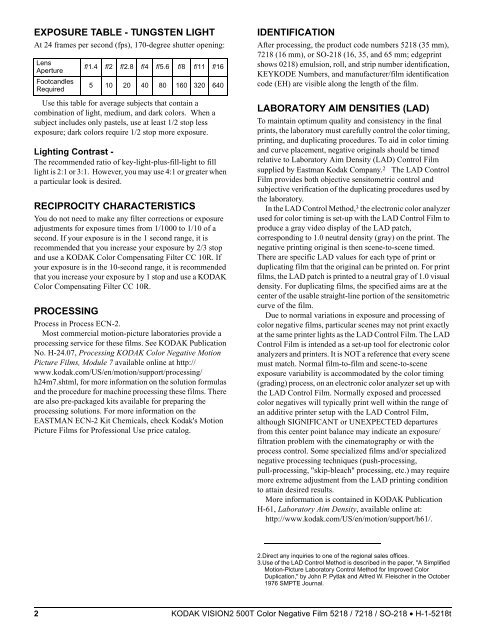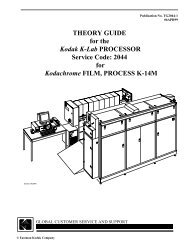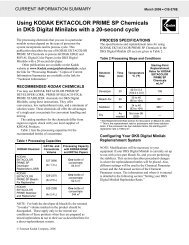KODAK VISION2 500T Color Negative Film 5218 / 7218 ... - 125px
KODAK VISION2 500T Color Negative Film 5218 / 7218 ... - 125px
KODAK VISION2 500T Color Negative Film 5218 / 7218 ... - 125px
You also want an ePaper? Increase the reach of your titles
YUMPU automatically turns print PDFs into web optimized ePapers that Google loves.
EXPOSURE TABLE - TUNGSTEN LIGHT<br />
At 24 frames per second (fps), 170-degree shutter opening:<br />
Lens<br />
Aperture<br />
Footcandles<br />
Required<br />
f/1.4 f/2 f/2.8 f/4 f/5.6 f/8 f/11 f/16<br />
5 10 20 40 80 160 320 640<br />
Use this table for average subjects that contain a<br />
combination of light, medium, and dark colors. When a<br />
subject includes only pastels, use at least 1/2 stop less<br />
exposure; dark colors require 1/2 stop more exposure.<br />
Lighting Contrast -<br />
The recommended ratio of key-light-plus-fill-light to fill<br />
light is 2:1 or 3:1. However, you may use 4:1 or greater when<br />
a particular look is desired.<br />
RECIPROCITY CHARACTERISTICS<br />
You do not need to make any filter corrections or exposure<br />
adjustments for exposure times from 1/1000 to 1/10 of a<br />
second. If your exposure is in the 1 second range, it is<br />
recommended that you increase your exposure by 2/3 stop<br />
and use a <strong>KODAK</strong> <strong>Color</strong> Compensating Filter CC 10R. If<br />
your exposure is in the 10-second range, it is recommended<br />
that you increase your exposure by 1 stop and use a <strong>KODAK</strong><br />
<strong>Color</strong> Compensating Filter CC 10R.<br />
PROCESSING<br />
Process in Process ECN-2.<br />
Most commercial motion-picture laboratories provide a<br />
processing service for these films. See <strong>KODAK</strong> Publication<br />
No. H-24.07, Processing <strong>KODAK</strong> <strong>Color</strong> <strong>Negative</strong> Motion<br />
Picture <strong>Film</strong>s, Module 7 available online at http://<br />
www.kodak.com/US/en/motion/support/processing/<br />
h24m7.shtml, for more information on the solution formulas<br />
and the procedure for machine processing these films. There<br />
are also pre-packaged kits available for preparing the<br />
processing solutions. For more information on the<br />
EASTMAN ECN-2 Kit Chemicals, check Kodak's Motion<br />
Picture <strong>Film</strong>s for Professional Use price catalog.<br />
IDENTIFICATION<br />
After processing, the product code numbers <strong>5218</strong> (35 mm),<br />
<strong>7218</strong> (16 mm), or SO-218 (16, 35, and 65 mm; edgeprint<br />
shows 0218) emulsion, roll, and strip number identification,<br />
KEYKODE Numbers, and manufacturer/film identification<br />
code (EH) are visible along the length of the film.<br />
LABORATORY AIM DENSITIES (LAD)<br />
To maintain optimum quality and consistency in the final<br />
prints, the laboratory must carefully control the color timing,<br />
printing, and duplicating procedures. To aid in color timing<br />
and curve placement, negative originals should be timed<br />
relative to Laboratory Aim Density (LAD) Control <strong>Film</strong><br />
supplied by Eastman Kodak Company. 2 The LAD Control<br />
<strong>Film</strong> provides both objective sensitometric control and<br />
subjective verification of the duplicating procedures used by<br />
the laboratory.<br />
In the LAD Control Method, 3 the electronic color analyzer<br />
used for color timing is set-up with the LAD Control <strong>Film</strong> to<br />
produce a gray video display of the LAD patch,<br />
corresponding to 1.0 neutral density (gray) on the print. The<br />
negative printing original is then scene-to-scene timed.<br />
There are specific LAD values for each type of print or<br />
duplicating film that the original can be printed on. For print<br />
films, the LAD patch is printed to a neutral gray of 1.0 visual<br />
density. For duplicating films, the specified aims are at the<br />
center of the usable straight-line portion of the sensitometric<br />
curve of the film.<br />
Due to normal variations in exposure and processing of<br />
color negative films, particular scenes may not print exactly<br />
at the same printer lights as the LAD Control <strong>Film</strong>. The LAD<br />
Control <strong>Film</strong> is intended as a set-up tool for electronic color<br />
analyzers and printers. It is NOT a reference that every scene<br />
must match. Normal film-to-film and scene-to-scene<br />
exposure variability is accommodated by the color timing<br />
(grading) process, on an electronic color analyzer set up with<br />
the LAD Control <strong>Film</strong>. Normally exposed and processed<br />
color negatives will typically print well within the range of<br />
an additive printer setup with the LAD Control <strong>Film</strong>,<br />
although SIGNIFICANT or UNEXPECTED departures<br />
from this center point balance may indicate an exposure/<br />
filtration problem with the cinematography or with the<br />
process control. Some specialized films and/or specialized<br />
negative processing techniques (push-processing,<br />
pull-processing, "skip-bleach" processing, etc.) may require<br />
more extreme adjustment from the LAD printing condition<br />
to attain desired results.<br />
More information is contained in <strong>KODAK</strong> Publication<br />
H-61, Laboratory Aim Density, available online at:<br />
http://www.kodak.com/US/en/motion/support/h61/.<br />
2.Direct any inquiries to one of the regional sales offices.<br />
3.Use of the LAD Control Method is described in the paper, "A Simplified<br />
Motion-Picture Laboratory Control Method for Improved <strong>Color</strong><br />
Duplication," by John P. Pytlak and Alfred W. Fleischer in the October<br />
1976 SMPTE Journal.<br />
2 <strong>KODAK</strong> <strong>VISION2</strong> <strong>500T</strong> <strong>Color</strong> <strong>Negative</strong> <strong>Film</strong> <strong>5218</strong> / <strong>7218</strong> / SO-218 • H-1-<strong>5218</strong>t

















